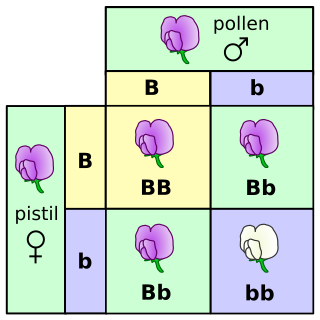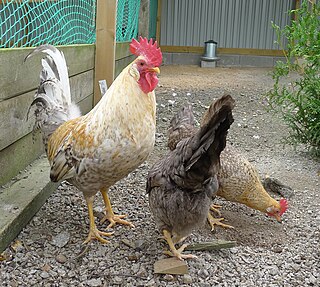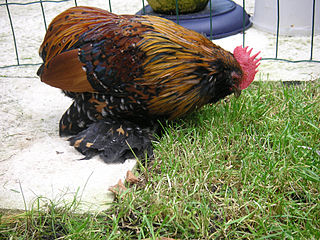
The Poltava is an old Ukrainian dual-purpose breed of chicken named after the Ukrainian city of Poltava. It includes three color varieties: Clay, Cuckoo, and Black.

The Poltava is an old Ukrainian dual-purpose breed of chicken named after the Ukrainian city of Poltava. It includes three color varieties: Clay, Cuckoo, and Black.
The Poltava Clay variety was included in the studies of genetic diversity and relationships between various chicken breeds:
The latter study was done in 1998—2000 within the framework of an international research project entitled «Development of Strategy and Application of Molecular Tools to Assess Biodiversity in Chicken Genetic Resources», or shortly AVIANDIV, [1] that was sponsored by European Commission and co-ordinated by Dr. Steffen Weigend, [2] of the Institute for Animal Breeding, [3] Mariensee, Germany.
The AVIANDIV project employed anonymous genetic markers, so called microsatellite loci spread across the whole genome. It was shown that 33 populations had no unique alleles, and 14 populations had one unique allele.

The genotype is the part of the genetic makeup of a cell, and therefore of any individual, which determines one of its characteristics (phenotype). The term was coined by the Danish botanist, plant physiologist and geneticist Wilhelm Johannsen in 1903.

A landrace is a domesticated, locally adapted, traditional variety of a species of animal or plant that has developed over time, through adaptation to its natural and cultural environment of agriculture and pastoralism, and due to isolation from other populations of the species. Landraces are generally distinguished from cultivars, and from breeds in the standardized sense, although the term landrace breed is sometimes used as distinguished from the term standardized breed when referring to cattle.

The Iberian horse is a title given to a number of horse breeds native to the Iberian peninsula. At present, no fewer than 18 horse breeds are officially recognized

The Noma is a critically-endangered Japanese breed of small horse. It originates from the island of Shikoku, the smallest of the four principal islands of Japan, and is named for the former district of Noma, the northernmost part of the former province of Iyo, now Ehime Prefecture. It is the smallest of the eight native horse breeds of Japan.

The Yurlov Crower is an old Russian breed of chicken primarily selected and used for long crowing cock contests in Russia.

The Livestock Conservancy, formerly known as the American Livestock Breeds Conservancy (ALBC) and prior to that, the American Minor Breeds Conservancy, is a nonprofit organization focused on preserving and promoting rare breeds, also known as "heritage breeds" of livestock. Founded in 1977, through the efforts of livestock breed enthusiasts concerned about the disappearance of many of the US's heritage livestock breeds, the Conservancy was the pioneer livestock preservation organization in the United States, and remains a leading organization in that field. It has initiated programs that have saved multiple breeds from extinction, and works closely with similar organizations in other countries, including Rare Breeds Canada. With 3,000 members, a staff of nine and a 19-member board of directors, the organization has an operating budget of almost half a million dollars.
The Poney du Logone is a breed of small horse or pony from the area of the Logone River in Chad and Cameroon, in west central Africa. It is particularly associated with the Musey or Moussey people of that region, and may also be known as the Poney Musey or Poney Mousseye.

The Mallorquín or Caballo Mallorquín is a rare breed of horse indigenous to the island of Mallorca in the Balearic Islands, from which it takes its name. Identification of the breed was begun in 1981 by the Patronato para las Razas Autóctonas de Mallorca. The Mallorquín is listed in the Catálogo Oficial de Razas de Ganado de España in the group of autochthonous breeds in danger of extinction.
Estonian Ruhnu sheep are a breed of native domesticated sheep found on the small Estonian island of Ruhnu in the Gulf of Riga in the Baltic Sea.

Jærhøns or Norske Jærhøns is the only indigenous breed of domestic chicken in Norway. It is named for the traditional district of Jæren in the county of Rogaland, where the breed was created based on one single parental pair of Norwegian landrace chickens. Other Norwegian landrace chickens no longer exist today.

The Barbu d'Everberg, Dutch: Everbergse Baardkriel, is a Belgian breed of bantam chicken. It is a tailless variant of the Barbu d'Uccle, and was bred in about 1906 at the Château d'Everberg, at Everberg in the municipality of Kortenberg, between Brussels and Leuven. It is among the most endangered chicken breeds in Belgium, and in 2010 its conservation status was classed as "critical". It is a true bantam, with no large counterpart. Cocks weigh 700–800 grams, and hens 550–650 g.
Genetic monitoring is the use of molecular markers to (i) identify individuals, species or populations, or (ii) to quantify changes in population genetic metrics over time. Genetic monitoring can thus be used to detect changes in species abundance and/or diversity, and has become an important tool in both conservation and livestock management. The types of molecular markers used to monitor populations are most commonly mitochondrial, microsatellites or single-nucleotide polymorphisms (SNPs), while earlier studies also used allozyme data. Species gene diversity is also recognized as an important biodiversity metric for implementation of the Convention on Biological Diversity.

The Fjäll is a traditional Swedish breed of polled mountain cattle. It was threatened with extinction in the 1970s and 1980s, but recovered after a breed association was formed in 1995, partly thanks to stocks of frozen semen. Microsatellite analysis has shown it to be closely related to the endangered Bohuskulla breed.
Turano-Mongolian cattle are a group of taurine cattle that are found in Northern and Eastern Asia. They are morphologically and genetically distinct from the Near Eastern group of taurine cattle and may have been domesticated independently.
The Brianzola is a breed of sheep from Lombardy in northern Italy. It originates in the historical region of the Brianza, from which it takes its name, and which coincides with the modern provinces of Como, Lecco and Monza and Brianza. It is raised principally in the comuni of Brianza, Civate, Galbiate, Proserpio, Suello and Valmadrera. It is a heavy meat breed; the wool is not used. It is one of the forty-two autochthonous local sheep breeds of limited distribution for which a herdbook is kept by the Associazione Nazionale della Pastorizia, the Italian national association of sheep-breeders.

The Ardennaise, French: Poule ardennaise, is a breed of domestic chicken from the Ardennes plateau, in Belgium and eastern France. Its range extends from the Pays de Herve in Wallonia to the French département of Ardennes, and includes the Fagnes, the Famenne, and the valleys of the Amblève, the Ourthe and the Semois.

Animal genetic resources for food and agriculture (AnGR) are a subset of genetic resources and a specific element of agricultural biodiversity. The term animal genetic resources refers specifically to the genetic resources of avian and mammalian species, which are used for food and agriculture purposes. Further terms referring to AnGR are "farm animal genetic resources" or "livestock diversity".
The Bohuskulla is an endangered Swedish breed of hornless mountain cattle. It originates from the area of the Kynnefjäll plateau in northern Bohuslän and Dalsland, in western Sweden. It is a traditional domestic Swedish breed, and derives from a group of cattle discovered in the 1990s in Skepplanda, in Västergötland, close to the border with Bohuslän. Microsatellite analysis has shown it to be closely related to the Fjällko mountain cattle of Sweden.

Mishima, Japanese: 見島, is an island in the Hagi Archipelago, in Yamaguchi Prefecture in the Chūgoku region of south-western Honshu, Japan. It lies in the Sea of Japan, approximately 44 km from Hagi. It has a surface area of approximately 7.73 km², and a population of 829 in 458 households.
| Wikimedia Commons has media related to Poltava (chicken) . |